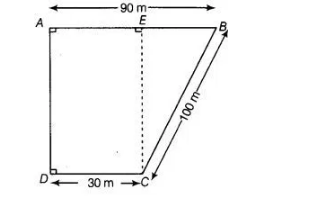A field is in the shape of a trapezium having parallel sides 90 m and 30 m. These sides meet the third side at right angles. The length of the fourth side
is 100 m. If it Rs. 4 costs to plough 1 m2 of the field, find the total cost of ploughing the field.
In trapezium ABCD, we draw a perpendicular line CE to the line AB.

We have, $D C=A E=30 \mathrm{~m}$
Now, $\quad B E=A B-A E=90-30=60 \mathrm{~m}$
In right angled $\triangle B E C$, $(B C)^{2}=(B E)^{2}+(E C)^{2} \quad$ [using Pythagoras theorem]
$\Rightarrow \quad(100)^{2}=(60)^{2}+(E C)^{2}$
$\Rightarrow \quad(E C)^{2}=10000-3600$
$\Rightarrow \quad(E C)^{2}=6400$
$\therefore \quad E C=\sqrt{6400}=80 \mathrm{~m}$
[taking positive square root because length is always positive]
$\therefore \quad$ Area of trapezium $A B C D=\frac{1}{2}$ (Sum of parallel sides) $\times$ Distance between parallel sides
$\therefore \quad$ Area of trapezium $A B C D=\frac{1}{2}$ (Sum of parallel sides) $\times$ Distance between parallel sides
$=\frac{1}{2}(A B+C D) \times E C=\frac{1}{2}(90+30) \times 80$
$=\frac{1}{2} \times(120) \times 80=4800 \mathrm{~m}^{2}$
$\because$ Cost of ploughing the field of $1 \mathrm{~m}^{2}=₹ 4$
$\therefore$ Cost of ploughing the field of $4800 \mathrm{~m}^{2}=4800 \times 4=₹ 19200$
Hence, the total cost of ploughing the field is $₹ 19200$.
